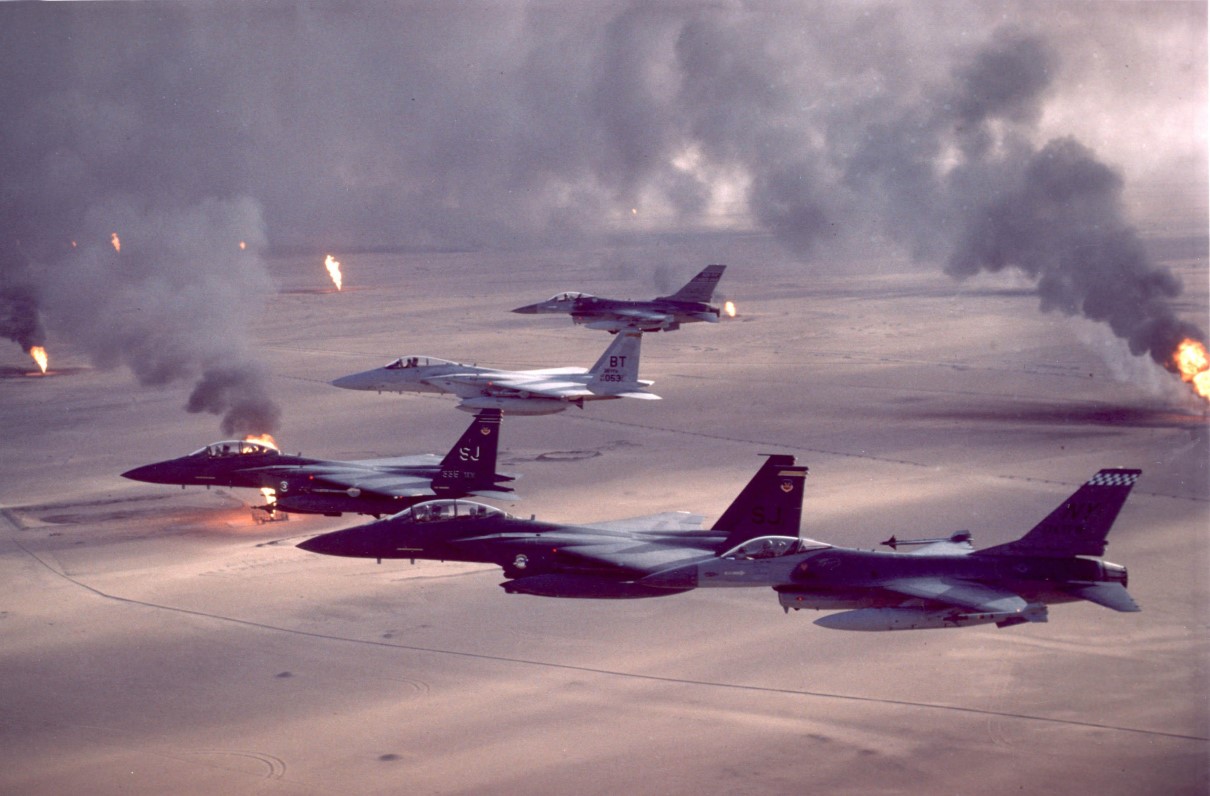(This article by Don Vaughan originally appeared in the January 2021 issue of Military Officer, a magazine available to all MOAA Premium and Life members. Learn more about the magazine here; learn more about joining MOAA here.)
Operation Desert Storm, which saw the largest air campaign since the Vietnam War, began 30 years ago this month.
The U.S.-led operation followed an ultimatum that Iraq stand down from an aggressive move against its neighbor, one that Iraq ignored.
[RELATED: MOAA Member Stories From Operation Desert Storm]
On Aug. 2, 1990, Iraqi forces crossed the border into Kuwait in a military action that would have tremendous international consequences. Iraq leader Saddam Hussein ordered the invasion in a bold attempt to claim Kuwait’s massive oil reserves and bolster his power within the region.
The global response to Saddam’s power grab was immediate, and the U.N. called it illegal.
The United Nations Security Council (UNSC) demanded that Iraq withdraw from Kuwait without delay. Iraq responded by declaring on Aug. 8 that it annexed Kuwait. The UNSC declared the annexation to be illegal.
Fearful of an attack on neighboring Saudi Arabia, the U.S. and western European NATO allies rapidly sent troops to the oil-exporting kingdom. Egypt and other Arab nations joined the coalition against Iraq, which was building up its forces, pouring an estimated 300,000 troops into Kuwait.
In November, the UNSC authorized the use of force if Iraq did not leave Kuwait by Jan. 15, 1991.
By early January, coalition forces totaled roughly 700,000, according to DoD estimates. Despite the tremendous show of force, Saddam ignored the ultimatum.
The clock ran out. Operation Desert Shield, the military buildup, ended, and Operation Desert Storm was launched. The allied military offensive began on Jan. 17 with a massive American-led air campaign, which devastated Iraq’s military forces and infrastructure.
The coalition allies focused on air attacks against Iraq’s forces in Kuwait and southern Iraq into February. On Feb. 24, the huge allied ground offensive, called Operation Desert Sabre, was launched. American armor attacked Iraq’s armored reserves from the rear, eliminating most of Iraq’s elite Republican Guard units.
During combat operations, the new MIM-104C Patriot missile system was used to intercept Scud missiles.
But on Feb. 25, one of the Scuds got through the defenses and hit a U.S. barracks near Dhahran, killing 28 American troops. Dozens more were wounded.
The allied military force used against Iraq during Desert Storm was incredible, with more than 18,000 air deployment missions, more than 116,000 air sorties, and 88,500 tons of bombs dropped, according to DoD. The six-week air campaign was devastating. The ground campaign to liberate Kuwait lasted 100 hours.
President George H.W. Bush declared a cease-fire on Feb. 28 as Iraqi resistance evaporated.
The consequences of the Persian Gulf War were horrific for Iraq: Casualty figure estimates vary widely, but they are believed to total in the tens of thousands. U.S. deaths totaled fewer than 400, according to DoD records.
The peace terms required Iraq to recognize the sovereignty of Kuwait and divest itself of all weapons of mass destruction and all missiles with a range of more than 90 miles.
A subsequent rebellion by Kurds in northern Iraq and Shiites in the south was brutally put down by Saddam, leading to the creation of no-fly zones monitored by the U.S., Britain, and initially France.
Don Vaughan writes about military and culture for MOAA.
Stay Informed
It’s more important than ever to make sure you’re in the know and your military benefits are protected.


